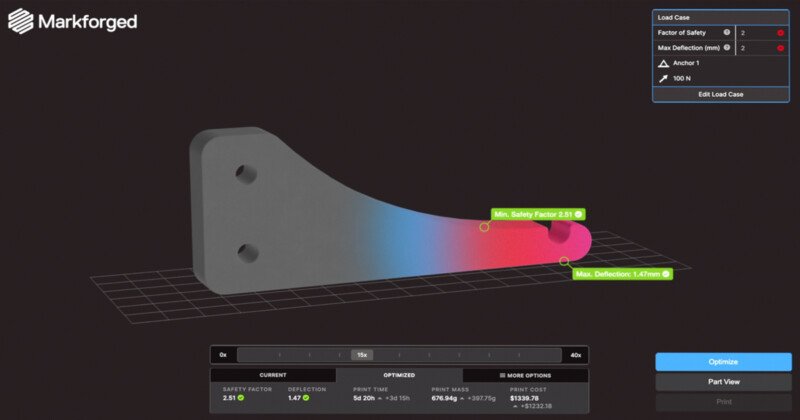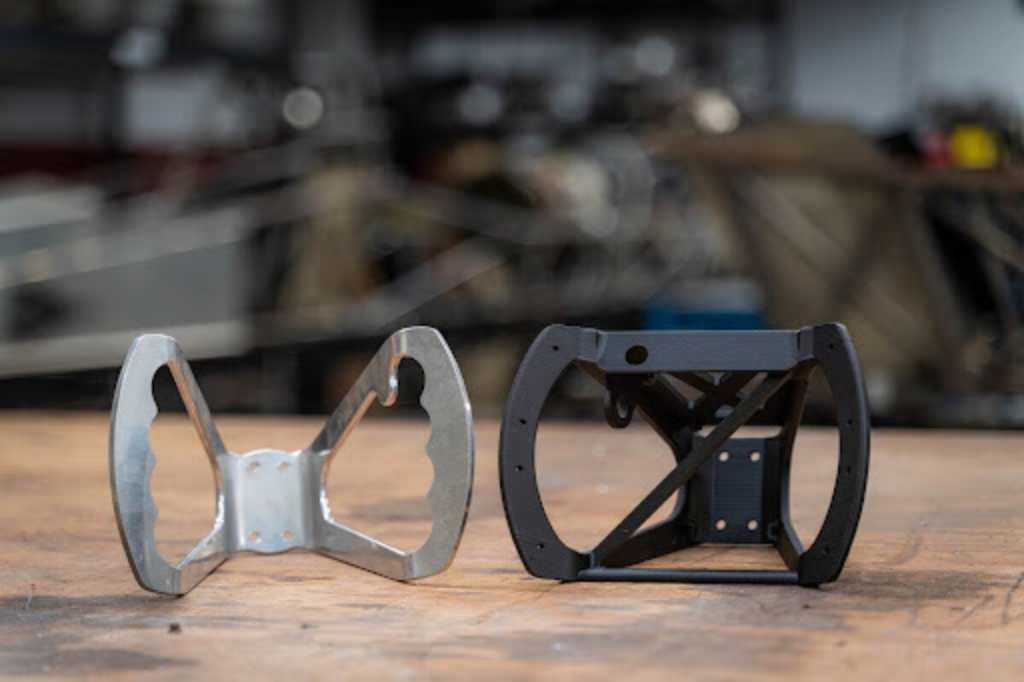
Introducing Simulation from Markforged
Since announcing plans to acquire Teton Simulation Software in April 2022, Markforged has been working to integrate Teton’s SmartSlice technology into our familiar Eiger workflow.
With Simulation, you can now virtually test the strength and stiffness of your parts right from your Eiger workflow — which means you can validate your part’s performance before you hit print.
Read this article to learn how to use Simulation, what problems it solves, how it works, and how manufacturers are using Simulation today.
How can I use Simulation?
Simulation is available immediately as a free trial to anyone with a Markforged Eiger account. If you don’t yet have an Eiger account, sign up to access Simulation for free.
Simulation is currently available as a free trial until April 2023, and will then shift to a paid subscription service.
What problems does Simulation solve?
3D printing parts for tooling and demanding end-use applications requires total confidence in the strength and performance of your part.
Traditionally, accomplishing this level of confidence required one of the following courses of action: 1.) lengthy design-print-break testing cycles that multiply lead times, consume excessive material, and require extra work to follow thorough testing protocols, 2.) time-consuming and costly analysis that requires both specialized expertise and expensive software, or 3.) consistently overbuilding parts with excess infill density and reinforcing material.
What are the benefits?
We promised to deliver a fast, automated way to validate part performance — and ultimately make it quick and effortless to print parts precisely optimized for the most demanding end-use applications. Our in-slicer Simulation feature means no more lengthy design-print-break testing cycles, costly and time-consuming analysis, or excess material put into overbuilt parts.
- Simulation instills confidence that your 3D printed parts will have the strength required for demanding industrial applications. Powerful simulation technology that’s optimized for additive manufacturing lets any user virtually test parts — taking the guesswork out of configuring print parameters to meet performance requirements.
- Simulation allows you to deliver trusted parts faster by reducing design-print-test iteration cycles and rework delays. Unlike traditional simulation tools that need specialized expertise and time-consuming analysis, Simulation is integrated into Eiger and streamlined for additive manufacturing so users can test parts within their familiar slice and print workflow.
- Simulation reduces the cost of 3D printed parts by automatically optimizing the amounts of material and continuous fiber reinforcement needed. Avoid overbuilt parts and wasted material by effortlessly applying settings that optimize to meet your needs for strength, cost, and print speed. Replacing the typical 5 to 25 iterations of trial and error printing with virtual testing can save hundreds or even thousands of dollars per part. Ultimately, this enables expanded use of fiber-reinforced composite parts — more metal tooling and end-use parts can be replaced in a manner that is faster, for cheaper, and effortlessly.
How does it work?
Simulation enables anyone producing 3D printed parts to validate part strength and stiffness. It suggests optimized print configurations to reduce print time or material costs.
With performance, cost, and time-frame requirements in mind, anyone can quickly:
- Press Validate after identifying anchor and load surfaces, entering values for loads, Factor of Safety, and Max Deflection (stiffness) to run a simulation that determines whether your part passes or fails.
- Press Optimize to run multiple simulations that generate alternative print configurations that prioritize faster print time or less material while ensuring performance requirements are satisfied.
- Press Print to fabricate the current configuration, or after applying one of the alternative part configurations.

“We can now test it with Simulation, iterate and keep iterating until we get a design we’re happy with. We don’t have to print ten different parts. We can do it all in Simulation.”
– Brian Tocci, Director of Operations, Larsen Motorsports
Who is using Simulation?
Larsen Motorsports, a research and development center for high-performance vehicles, is using Simulation from Markforged to improve the designs of steering wheels in its jet engine drag racing vehicles.
The stock aluminum steering wheels which they’ve historically purchased and then modified (in a lengthy process) are shaped for much larger hands than those of rookie House of Kolor-sponsored dragster driver, Josette Roach — putting both safety and performance at risk. Larsen Motorsports began exploring the benefits of using 3D printing to print new steering wheels that could 1.) provide a better grip, and 2.) quickly implement important design elements missing in the stock aluminum part that would otherwise take weeks or months to arrive.
Timing is everything. Before races, Larsen needs to be ready with the best possible equipment to maximize safety for drivers and put them in a position to succeed. Supply chain delays — here, long lead times for necessary modifications — jeopardize Larsen’s ability to stay ready. Looking for a reliable and repeatable solution to ongoing supply chain delays, Larsen Motorsports explored Markforged’s Simulation feature through beta availability.
Simulation enabled Larsen to improve the design and optimize the print configuration of an Onyx™ steering wheel with Continuous Fiber Reinforcement (CFR). Physical testing of the 3D printed steering wheel confirmed that it had the strength and stiffness needed to replace the aluminum stock parts. Ultimately, this allowed them to deliver the high-performance parts they need faster — in this case, steering wheels they trust to keep their drivers safe and allow them to perform.


